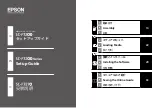
--------------
THERMAL RECEIPT PRINTER-
------------
7
CAN (*)
[Name] Cancel print data in page mode
[Format] ASCII CAN
Hex 18
Decimal 24
[Description] In page mode, deletes all the print data in the current printable area.
[Details]
•
This command is enabled only in page mode.
•
If data that existed in the previously specified printing area also exists in the
currently specified printing area, it is deleted.
[Reference]
ESC L
,
ESC W
DLE EOT
n (*)
[Name] Real-time status transmission
[Format] ASCII DLE EOT n
Hex 10 04 n
Decimal 16 4 n
[Range] 1
≤
n
≤
4
[Description] Transmits the selected printer status specified by n in real-time, according to the
following parameters:
n = 1: Transmit printer status
n = 2: Transmit off-line status
n = 3: Transmit error status
n = 4: Transmit paper roll sensor status
[Details]
•
The status is transmitted whenever the data sequence of <10>H<04>H< n>
(1
≤
n
≤
4) is received.
Example:
In
ESC
∗
m n
L
n
H
d1...dk
, d1=<10>H, d2=<04>H, d3=<01>H
•
This command should not be used within the data sequence of another
command that consists of 2 or more bytes.
Example:
If you attempt to transmit
ESC 3 n
to the printer, but DTR (DSR for the host
computer) goes to MARK before n is transmitted and then
DLE EOT 3
interrupts before n is received, the code <10>H for
DLE EOT 3
is processed
as the code for
ESC 3 <
10>H.
•
Even though the printer is not selected using
ESC =
(select peripheral device),
this command is effective.
•
The printer transmits the current status. Each status is represented by onebyte
data.
•
The printer transmits the status without confirming whether the host computer
can receive data.
•
The printer executes this command upon receiving it.
•
This command is executed even when the printer is off-line, the receive buffer
is full, or there is an error status with a serial interface model.
•
With a parallel interface model, this command can not be executed when the








































